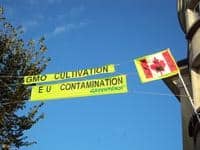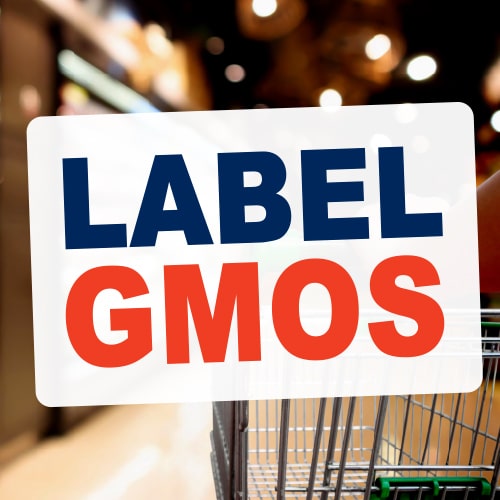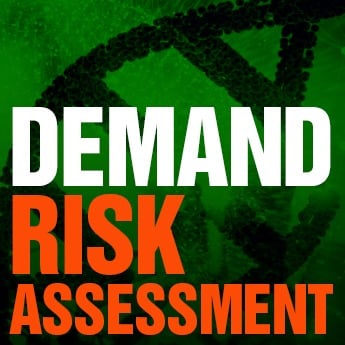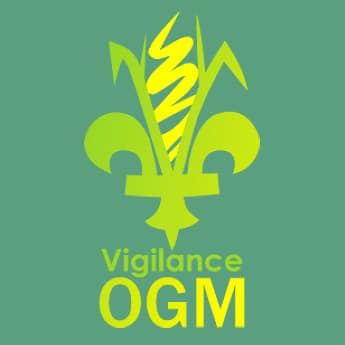Le lin
Résumé
Il est illégal de vendre des semences de lin génétiquement modifiées au Canada. On n’en a jamais cultivé ni vendu sur le marché de la consommation. L’Université de la Saskatchewan au Canada a mis au point un lin GM approuvé par le gouvernement canadien en 1996-1998. On a produit des semences de lin GM pour les vendre aux agriculteurs, mais en 2001, le Flax Council of Canada et la Saskatchewan Flax Development Commission, qui représentent les agriculteurs, ont convaincu l’Agence canadienne d’inspection des aliments de retirer l’enregistrement de la variété du lin GM dans le but de protéger les marchés d’exportation du lin (environ 60 % des exportations de lin du Canada sont expédiées en Europe).
L’organisme européen de système d’alerte alimentaire (Rapid Alert System for Food and Feed) a confirmé la contamination des exportations canadiennes de lin avec une variété de lin génétiquement modifié (GM) qui était illegal à la vente au Canada depuis 2001, année à laquelle les liniculteurs avaient obligés le gouvernement à retirer le produit du marché. Cette contamination a été confirmée dans les exportations des céréales, des produits boulangers ou contenant des noix, ainsi que des plats cuisinés.
Ce lin GM n’avait jamais été approuvé à la consommation humaine dans les 35 pays où la contamination a été relevée. En septembre – octobre 2009, ces derniers ont fermé leurs marchés au lin canadien. Le Canada s’est vu fermer la porte de l’Autriche, la Belgique, la Croatie, Chypre, la République Tchèque, le Danemark, l’Égypte, l’Estonie, la Finlande, la France, l’Allemagne, la Grèce, la Hongrie, l’Islande, l’Ireland, l’Italie, la Lettonie, le Luxembourg, la Hollande, la Norvège, la Pologne, le Portugal, la Corée, la Roumanie, Singapour, la Slovaquie, la Slovénie, l’Espagne, le Sri Lanka, la Suède, la Suisse, la Thaïlande, le Royaume-Uni et le Japon.
Additional Information:
Background >
GM Triffid Flax Timeline >
GM Contamination Crisis Updates! >
Background:
 A GM flax (tolerant to herbicide residues in soil) was developed by controversial scientist and industry proponent Alan McHughen when he worked for the Crop Development Centre (CDC) at the University of Saskatchewan. McHughen called the GM flax, « CDC Triffid » in reference to John Whyndham’s 1951 horror novel, « The Day of the Triffids » which features terrifying flesh eating plants farmed for oil. The flax was developed with public money through provincial government funding to the CDC. However, the CDC halted its GM research after the flax controversy.
A GM flax (tolerant to herbicide residues in soil) was developed by controversial scientist and industry proponent Alan McHughen when he worked for the Crop Development Centre (CDC) at the University of Saskatchewan. McHughen called the GM flax, « CDC Triffid » in reference to John Whyndham’s 1951 horror novel, « The Day of the Triffids » which features terrifying flesh eating plants farmed for oil. The flax was developed with public money through provincial government funding to the CDC. However, the CDC halted its GM research after the flax controversy.
The « CDC Triffid » was approved by Health Canada and the Canadian Food Inspection Agency but was never commercially grown in Canada. In 2001 about 40 seed growers were multiplying 200,000 bushels of seed for future use but this was all crushed when the flax was taken off the market that year.
Canada is the world’s leader in the production and export of flax. Flax is one of Canada’s five major cash-crops, alongside wheat, barley, oats and canola. Canada currently ships 60% of its flax exports to the EU, 30% to the United States, and 4% to Japan. Between 500,000 – 700,000 bushels go to Europe. Before the contamination scandal, cash bids for flax in Manitoba were 9.90-9.92 a bushel. But just based on rumour, before contamination was confirmed, flax bids in Manitoba were down to $6.78 a bushel. This is a fall in price of 32% before the GM contamination was even confirmed.
Triffid Timeline
The CFIA has verified the below timetable that CBAN has constructed:
1996: GE “CDC Triffid” flax granted environmental release approval from Agriculture Canada (The CFIA was not yet formed).
1996: Triffid flax granted variety registration from Agriculture Canada, making it legal to sell the seeds.
1996: Triffid flax approved for animal feed – animal health assessment and worker health and safety, handling – from Agriculture Canada.
1998: Health Canada approval for human consumption as food granted.
2001 (April 1): Triffid deregistered by the CFIA, making it illegal to sell the seeds in Canada.
GM Contamination Crisis Updates!
“GE contamination is already costing the taxpayer. The fact that the Harper Government recently pledged up to $1.9 million to help companies pay for testing flax seed is evidence that GE contamination can cost the Canadian government – and this is without the government compensating farmers for their testing costs or market loss. Contamination is inevitable and these costs will keep reoccurring.” – Lucy Sharratt, CBAN Coordinator, from March 16 Press Release Parliament to debate the need for export market acceptance before commercial release
March 4, 2010: Farm saved flax seed protected! Grain company Viterra and others wanted to force farmers wishing to grow flax in 2010 for Europe to abandon their farm-saved seed and purchase certified seed instead. The industry failed in this attempt. The reversal was announced by the Flax Council of Canada after it learned that that breeder seed samples from three more flax varieties (that makes five in total!) have tested positive for GE contamination! Farmers were very clear that they wanted to keep their saved seed. About 75% of Canada’s flax farmers use farm-saved seed. “The best solution is to test the seed supply, both farm-saved seed and certified seed,”said National Farmers Union President and flax producer Terry Boehm. Buying certified seed would have added another cost to farmers who face lower prices and market uncertainty, and are already paying for testing and cleanup.
March 4, 2010: Bill C-474 would stop GE seeds from creating market chaos as seen in the current flax contamination crisis. Click here for information and to take action.
January 18, 2010: Press Release, « Grain Companies Exploit Flax Situation to tighten vise on farmer seed saving » National Farmers Union.
November 18, 2009 : 35 Countries hit by flax contamination as Japan find contamination.
New! October 29, 2009 –Flax contamination briefing for Members of Parliament.
October 5, 2009 – Press Release: GM Flax Contamination from Canada Soars to 28 Countries: But Canadian farmers still have no answers
October 2, 2009 – Update: Protest at Canadian Consulate in Luxembourg over GM flax contamination from Canada, « GMO Cultivation = EU Contamination ».
 September 10, 2009 – Press release: Illegal GM Flax Contaminates Canadian Exports: Contamination of European food threatens Canadian export markets
September 10, 2009 – Press release: Illegal GM Flax Contaminates Canadian Exports: Contamination of European food threatens Canadian export markets





